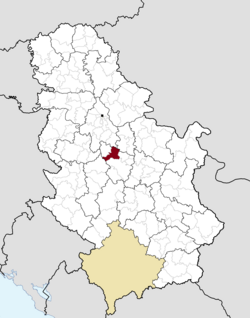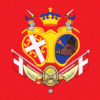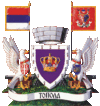Topoľa
|
Topola Топола |
|||
|---|---|---|---|
| Town and municipality | |||

Topola with Oplenac at its hilltop
|
|||
|
|||
 Location of the municipality of Topola within Serbia |
|||
| Country |
|
||
| Region | Šumadija and Western Serbia | ||
| District | Šumadija | ||
| Settlements | 31 | ||
| Government | |||
| • Mayor | Dragan Jovanović (NS) | ||
| Area | |||
| • Municipality | 356 km2 (137 sq mi) | ||
| Population (2011 census) | |||
| • Town | 4,573 | ||
| • Municipality | 22,207 | ||
| Time zone | CET (UTC+1) | ||
| • Summer (DST) | CEST (UTC+2) | ||
| Postal code | 34310 | ||
| Area code | +381 34 | ||
| Car plates | TO | ||
| Website | www |
||
Topola (Serbian Cyrillic: Топола, [tɔpɔ̌la]) is a town and municipality located in the Šumadija District of the central Serbia. It was the place where Karađorđe, a Serbian revolutionary, was chosen as the leader of the First Serbian Uprising against the Ottoman Empire in 1804. The local St. George Church is the burial place of the Ducal and Royal Family of Serbia and Yugoslavia (the Karađorđevićes).
The name Topola means poplar. Topola is famous for its yearly Oplenac vintage festival, attended by several thousand visitors each year.
Aside from the town of Topola, the municipality includes the following settlements, according to 2002 census (population in brackets):
The region was heavily settled after the Battle of Kosovo in 1389, seen in the many medieval cemeteries in villages of Topola. Despot Stefan Lazarević died and was buried in the nearby Crkvine hamlet. On June 20, 1459, the city of Rudnik fell to the Ottomans, situated south of Topola. A hamlet was named Despotovica in memory of the fallen Serbian Despotate. The region was further settled with the great migration of Serbs in the 17th century.
The town was established in 1781, by Vožd Karageorge, on the right of the Kamenica river. The town was destroyed during the First Serbian Uprising, when Kučuk-Alija ravaged the Šumadija region in 1804, also burning down Karageorge's house. The renovation began in 1805, when the town was renewed as a fortified city; Karageorge built a new mansion on the ruins of his previous house, and several buildings surrounding, they were all protected with palisades and peep holes, making Topola a strategic settlement. With the successful revolts, Topola gains a political importance. The Vožd further expanded the town, from 1808 to 1813 he built large walls, towers, konaks, a school, a church and many other buildings. Topola became the centre of Revolutionary Serbia, where Karageorge was seated.
...
Wikipedia


